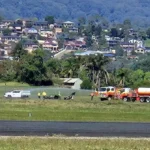The picturesque islands of the Cyclades continue to be shaken by a series of moderate to strong earthquakes, with the strongest yet recorded on Wednesday evening (February 5) in the region between Santorini and Amorgos. The magnitude 5.2 quake, according to the Greek National Observatory, has sent shockwaves through the community and raised concerns about the possibility of a larger, more destructive earthquake in the future.
As the scientific community continues to study the phenomenon, authorities are taking no chances. The Greek Organization for Anti-Seismic Planning and Protection (OASP), led by President Efthymios Lekkas, has identified five high-risk areas in Santorini and is working with local authorities to implement measures to mitigate the risk of damage to the island and its inhabitants.
“We have mapped the regions and pinpointed five high-risk areas,” Lekkas explained during a press conference earlier this week. “Based on this data, we selected five locations with significant risk where measures will be implemented: the Old Port of Fira, the Port of Athinios and the road network of the Ormos, Oia, specifically the areas of Ammoudi and Armeni, and Thirasia.”
Lekkas and other experts believe that the seismic activity is centered around a fault line located between Amorgos and Santorini, which is not the same fault responsible for the devastating 1956 earthquake that ravaged the island.
“There is also a set of fault lines in the area,” Lekkas pointed out. “However, the significant fault currently does not have the capacity to activate. We are monitoring the situation closely and working with international experts to better understand the dynamics at play.”
Kostas Papazachos, a renowned seismologist from the University of Athens, believes that the situation is “not as alarming as it seems” and that the likelihood of a major earthquake is low. However, he warned that the region is prone to strong earthquakes and that the potential for a magnitude 6 or higher quake cannot be ruled out.
“The fault line is complex, and there are many variables at play,” Papazachos explained. “While the possibility of a major earthquake is low, it is not impossible. We need to be prepared for any eventuality and take the necessary precautions to protect the inhabitants of the island and the surrounding areas.”
In response to the heightened seismic activity, the Greek authorities have deployed a range of emergency services, including the police, fire services, coast guard, and military forces, to the island. The municipality of Santorini is also on high alert, with a range of measures in place to respond to potential emergencies.
As the situation continues to unfold, experts are urging caution and emphasizing the importance of being prepared for any eventuality. “We are not out of the woods yet,” warns Papazachos. “The seismic activity could increase or decrease, and we need to be prepared for both scenarios.”
In the meantime, the Greek National Observatory is continuing to closely monitor the situation, issuing frequent updates and advisories to citizens and authorities alike. As the region remains on high alert, one thing is clear: the people of the Cyclades will not let the threat of a larger earthquake dampen their spirits or compromise their love for this beautiful and resilient region.
What’s happening?
- A series of moderate to strong earthquakes have shaken the Cyclades region between Santorini and Amorgos.
- The strongest quake yet recorded was a magnitude 5.2 on February 5.
- Authorities have identified five high-risk areas on the island of Santorini.
- A range of emergency services, including the police, fire services, coast guard, and military forces, have been deployed to the island.
- Experts warn that the situation is complex and that the potential for a major earthquake cannot be ruled out.
What’s next?
- The Greek National Observatory will continue to closely monitor the situation and issue updates as necessary.
- Authorities will work with local communities to implement measures to mitigate the risk of damage to the island and its inhabitants.
- Citizens are advised to remain informed and be prepared for any eventuality.












